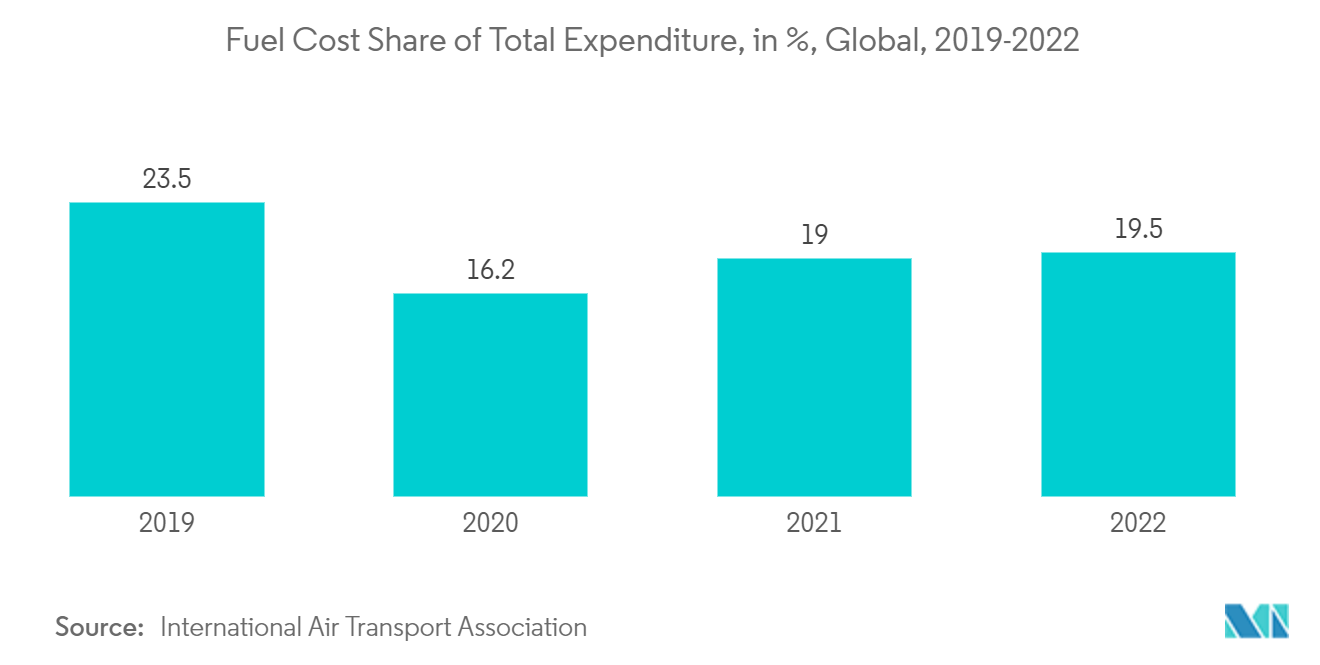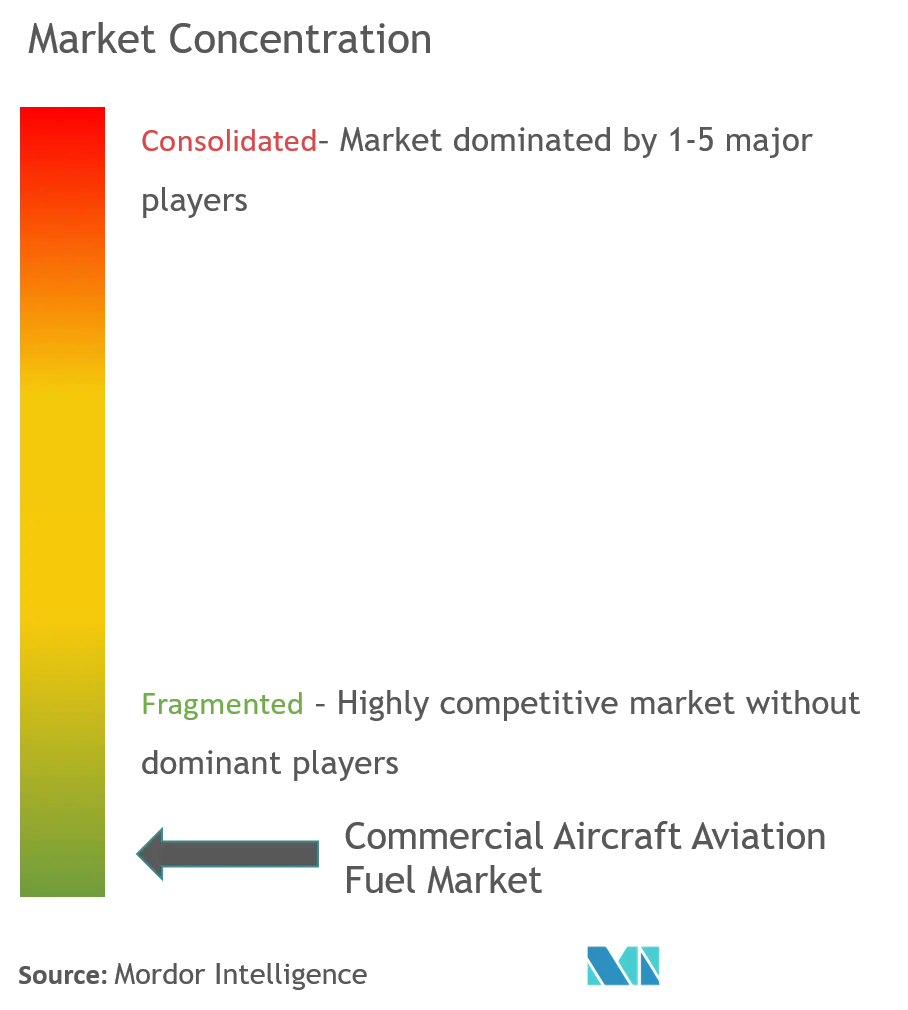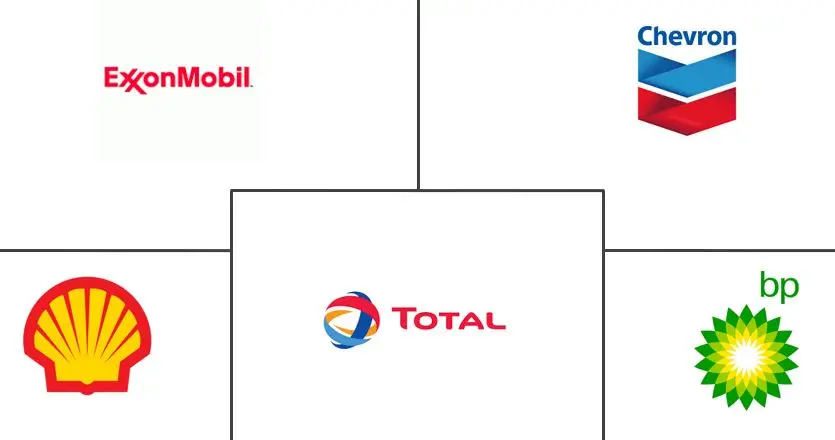
Commercial Aircraft Aviation Fuel Market Analysis by Mordor Intelligence
The Commercial Aircraft Aviation Fuel Market is expected to register a CAGR of greater than 20.86% during the forecast period.
The commercial aviation fuel market was adversely affected by COVID-19 due to regional lockdowns. However, the market rebounded in 2021.
- Scheduled and non-scheduled aircraft are a part of commercial aviation. These planes carry people or goods for a fee.During the next few years, the market is likely to be driven by things like the growing number of air travelers and aircraft fleets around the world.
- However, the high cost of aviation fuel is expected to restrain market growth.
- Concerns about emissions from the airline industry are growing, and governments in developed economies are taking steps to reduce airline emissions. In the coming years, this is likely to create a lot of opportunities for commercial aircraft aviation fuel.
- Asia-Pacific is expected to be the fastest-growing market during the forecast period, with the majority of the demand coming from countries like China, India, Japan, etc.
Global Commercial Aircraft Aviation Fuel Market Trends and Insights
Air Turbine Fuel (ATF) Type to Dominate the Market
- Jet-A-specified fuel has been used in the United States since the 1950s, and it is usually not available outside the United States and a few Canadian airports, such as Toronto and Vancouver. Jet-A has the same flash point as Jet-A1 but a higher freeze point maximum (-40°C). It is supplied against the ASTM D1655 (Jet A) specification. Jet A1 is suitable for most turbine-engine aircraft. It has a flash point minimum of 38 °C (100°F) and a freeze point maximum of -47 °C. Jet A1 is widely available outside of the United States.
- LanzaTech's ethanol-based ATJ-SPK was made eligible for use as a blending component with standard Jet-A for commercial airline use in the United States and in most countries around the world. Under the revised ASTM D7566, LanzaTech ATJ-SPK is eligible to be used up to a 50% blend in conventional jet fuel for commercial flights.
- Jet-A fuels have been witnessing developments from universities in recent years. For instance, in June 2021, researchers at Washington State University developed a process for turning waste plastics into sustainable jet-A fuel. If the process is refined and applied on a large scale, the procedure is expected to address major environmental problems, including greenhouse gas emissions and plastic pollution.
- The primary industry classifies the cities with the most aviation connectivity and international passengers as "aviation megacities" (AMC). According to Airbus, there are 66 AMCs, with over 60% of traffic flying to and from these cities and 17% between AMCs alone. With the increase in AMCs across the world, long-haul flights are increasing exponentially, driving the demand for jet fuels and thus increasing the demand for aviation fuel in the commercial sector.
- Therefore, based on the above-mentioned factors, air turbine fuel (ATF) is expected to dominate the commercial aircraft aviation fuel market during the forecast period.

Asia-Pacific to Dominate the Market
- Asia-Pacific is one of the significant aviation fuel markets in the commercial segment. In recent years, the fastest-growing markets, such as India and Southeast Asia, are increasingly contributing to the region's growth as these emerging economies have been endorsing robust passenger growth. As per the International Air Transport Association (IATA), in the Asia-Pacific region, countries including China, India, Indonesia, and Vietnam are expected to witness the highest passenger traffic by 2035.
- Furthermore, the Boeing Commercial Market Outlook (CMO) 2021-2040 says that the number of people traveling between the regions will go up a lot by 2040. So, the rise in passenger traffic is likely to give everyone in the supply chain, especially in emerging regions, a lot of chances to grow and meet the growing demand in the future.
- Also, commercial airline fleets have been growing over the past ten years, and as of January 2022, there were 22,799 planes in use around the world. The number of passengers is directly related to the number of commercial flights, and both Boeing and Airbus are steadily getting more orders and delivering more planes.
- China is one of the largest aviation fuel markets globally, and it is also one of the largest in terms of air passengers carried. As of 2021, domestic passengers in China were the second largest in the aviation market after the United States.
- Japan Airlines (JAL) and All Nippon Airways (ANA) are the two largest commercial airlines in Japan. However, low-cost carriers (LCCs) like Peach Aviation, Jetstar Japan, and Vanilla Air are gaining market share and boosting the aviation market in the country.
- Based on all of these factors, Asia-Pacific is expected to lead the market for aviation fuel for commercial aircraft during the forecast period.

Competitive Landscape
The commercial aviation fuel market is fragmented. Some of the major players (in no particular order) include Exxon Mobil Corporation, Chevron Corporation, Shell PLC, TotalEnergies SE, and BP PLC.
Commercial Aircraft Aviation Fuel Industry Leaders
-
Exxon Mobil Corporation
-
Chevron Corporation
-
BP PLC
-
TotalEnergies SE
-
Shell PLC
- *Disclaimer: Major Players sorted in no particular order

Recent Industry Developments
- March 2022: United Airlines, through its corporate venture capital fund, United Airlines Ventures (UAV), and with Oxy Low Carbon Ventures (a subsidiary of Occidental), have announced a collaboration with Houston-based biotech firm CemvitaFactory to commercialize the production of sustainable aviation fuel (SAF), developed through a new process using carbon dioxide (CO2) and synthetic microbes.
- March 2022: Pratt & Whitney announced a memorandum of understanding with AirBP with respect to the application of sustainable aviation fuel (SAF) blends at up to 100 percent in Pratt & Whitney engine testing and research. As part of the agreement, both companies will work collaboratively to explore the viability of supplying Pratt & Whitney with SAF blends.
Global Commercial Aircraft Aviation Fuel Market Report Scope
Aviation fuels are petroleum-based fuels or mixtures of petroleum and synthetic fuels that are used to power airplanes. They have to follow stricter rules than fuels used for stationary purposes, like heating and driving, and they have additives that improve or keep important fuel management or performance characteristics. By fuel type and geography, the commercial aviation fuel market is segmented. By fuel type, the market is segmented into air turbine fuel, aviation biofuel, and others. The report also covers the market size and forecasts for the commercial aircraft aviation fuels market across the major regions. For each segment, market sizing and forecasts have been done based on revenue (USD billion).
| Air Turbine Fuel (ATF) |
| Aviation Biofuel |
| Other Fuel Types |
| North America |
| Europe |
| Asia-Pacific |
| South America |
| Middle-East and Africa |
| Fuel Type | Air Turbine Fuel (ATF) |
| Aviation Biofuel | |
| Other Fuel Types | |
| Geography | North America |
| Europe | |
| Asia-Pacific | |
| South America | |
| Middle-East and Africa |
Key Questions Answered in the Report
What is the current Commercial Aircraft Aviation Fuel Market size?
The Commercial Aircraft Aviation Fuel Market is projected to register a CAGR of greater than 20.86% during the forecast period (2025-2030)
Who are the key players in Commercial Aircraft Aviation Fuel Market?
Exxon Mobil Corporation, Chevron Corporation, BP PLC, TotalEnergies SE and Shell PLC are the major companies operating in the Commercial Aircraft Aviation Fuel Market.
Which is the fastest growing region in Commercial Aircraft Aviation Fuel Market?
Asia Pacific is estimated to grow at the highest CAGR over the forecast period (2025-2030).
Which region has the biggest share in Commercial Aircraft Aviation Fuel Market?
In 2025, the North America accounts for the largest market share in Commercial Aircraft Aviation Fuel Market.
What years does this Commercial Aircraft Aviation Fuel Market cover?
The report covers the Commercial Aircraft Aviation Fuel Market historical market size for years: 2019, 2020, 2021, 2022, 2023 and 2024. The report also forecasts the Commercial Aircraft Aviation Fuel Market size for years: 2025, 2026, 2027, 2028, 2029 and 2030.
Page last updated on:
Commercial Aircraft Aviation Fuel Market Report
Statistics for the 2025 Commercial Aircraft Aviation Fuel market share, size and revenue growth rate, created by Mordor Intelligence™ Industry Reports. Commercial Aircraft Aviation Fuel analysis includes a market forecast outlook for 2025 to 2030 and historical overview. Get a sample of this industry analysis as a free report PDF download.



